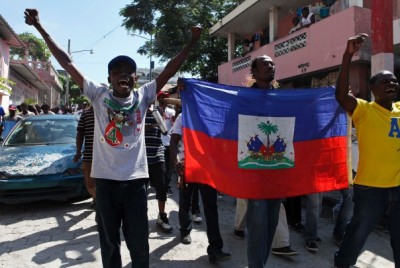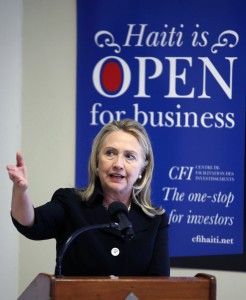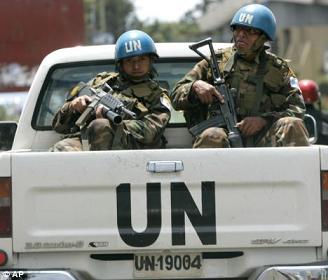Haiti, Five Years After the Earthquake: Fraudulent Reconstruction Under Military Occupation

This article was first published by GR in January 2015
Five years after the devastating earthquake, numerous massive protests were held against the UN occupation (MINUSTAH) and for the departure of Haitian President Michel Martelly and Prime Minister Laurent Lamothe. The latter finally resigned in December 2014.
These demonstrations did not make their way into the mainstream media in 2014.
Why?
When anti-government protests occur in a country which is not led by a U.S. ally, there is extensive coverage. Haiti’s current leaders are “suitable” for Western leaders, most of all for the U.S. since it actually chooses Haiti’s leaders, not the Haitian people.
On January 12 there will be extensive coverage of the 5th anniversary of the devastating earthquake but the major issues and structural problems will either not be addressed or, at best, will be presented in a way that supports the deceitful notion of the white man’s burden. “Haiti needs our help.” Or does it? And what kind of help are we talking about?
“International aid” is nothing but a capitalist, imperial tool designed to keep the South captive of the North’s disastrous neoliberal policies which hinder genuine development and prevent the South’s economic and political sovereignty.
Where does aid money go? In the very pockets of those who pretend to give.
Haiti is probably the best example of the scam international aid really is.
Bush and Clinton the saviors
As a good neoliberal never letting a serious crisis go to waste, Bill Clinton, saw the 2010 earthquake as a great opportunity. As Dady Chery notes:
[At the beginning of the U.S. Occupation in 1915] a treaty was forced on Haiti that created the post of US High Commissioner, to run the country alongside its hand-picked “Haitian” president… Control of the country’s finances, public works, and public health services were transferred to southern US Democrats who had supported Wilson’s campaign, in much the same way that these are transferred today to USAID and non-governmental organizations (NGO). The idea then was the same as now: all Haiti’s economy should serve the US, and nearly all US dollars paid as wages in Haiti should return to the US.
Clinton saw in the earthquake of 2010 his opportunity to become the new US High Commissioner of Haiti… Within four months of the earthquake, he formed the Interim Commission for the Reconstruction of Haiti (CIRH): a strictly pay-to-play group of officials/rich businessmen from the MINUSTAH countries and others who agreed to contribute armed personnel from their countries or money … in return for a piece of the action in Haiti. After some arm twisting and bribery, the Haitian parliament was forced to declare a state of emergency for 18 months during which Clinton and his CIRH gang could do as they pleased with regard to reconstruction, without risk of liability. One year and a half came and went, and when the Haitian Senate observed that nothing much had been accomplished, the state of emergency was not renewed, and the CIRH was alleged to be fraudulent. (Dady Chery, Haiti: Time for Clinton and Co to Pack and Go, News Junkie Post, December 15, 2014)
Bill Clinton’s nefarious influence on the country is not new. A study of the economic liberalization strategies imposed by the U.S. on Haiti in the 1980s and 1990s showed that “President Clinton and other recent White House tenants condemn[ed] Haiti to a future of endemic poverty through a self-serving U.S. rice export policy”:
The U.S. Agency for International Development (USAID), among other agencies, encouraged Haiti to start exporting manufactured and processed agricultural products, in tandem with emphasizing the need to import grain staples on the international market… U.S. experts worked to disassemble Haiti’s rural economy, even though USAID officials recognized that such a move could increase poverty and contribute to a decline in average Haitian income and health standards. By 2003, approximately 80% of all rice consumed in Haiti was imported from the United States.” (Leah Chavla, Bill Clinton’s Heavy Hand on Haiti’s Vulnerable Agricultural Economy: The American Rice Scandal, Council on Hemispheric Affairs, April 13, 2010.)
The business of disaster relief and international aid
 Haiti’s earthquake was an opportunity for “business”. Several industries —mining, garment, tourism, only to name a few— profited from the disaster. Donations have favoured businesses in the donor countries more than Haitians themselves and several projects have seen cost overruns and others ended up being useless due to the critical lack of infrastructure.
Haiti’s earthquake was an opportunity for “business”. Several industries —mining, garment, tourism, only to name a few— profited from the disaster. Donations have favoured businesses in the donor countries more than Haitians themselves and several projects have seen cost overruns and others ended up being useless due to the critical lack of infrastructure.
It is a well-known and documented fact in independent media circles that international aid is nothing but business masquerading as charity. Approximately 80% of the aid money dedicated to developing countries ends up in the coffers of businesses and non-governmental organizations (NGOs) from the donor countries. Far from helping, this dynamic only creates a relationship of dependency hampering, even preventing the “recipient” country from developing the very structures which could liberate it from this colonial relationship.
While most people working for Western humanitarian organizations are well-intentioned, Western “humanitarian” policies towards countries like Haiti are deliberately designed to maintain the financial superiority of the North on the South. This has been demonstrated by the disastrous effects of the International Monetary Fund’s infamous Structural Adjustment Programs, focused on massive privatization, free trade and which have destroyed local economies, agriculture and food sovereignty in countries which now rely on “food aid”. That’s what happened in Haiti:
While some U.S. government agencies say their programs have been meant to alleviate hunger and promote agricultural production, other programs have helped pry open Haiti’s market, creating millions of new consumers for U.S. agricultural products like rice, poultry, pork and other products while undermining local agricultural production and changing Haitian eating habits.
Because some 50% to 60% of the population still makes their living in the agricultural sector, these policies have had extremely negative effects on the economy at large. For example, a 2006 study from Christian Aid estimated that 831,900 people had been directly affected by the 1995 lowering of tariffs that once protected Haitian sugar, rice, and chicken.
Haiti now imports at least 50% of its food, mostly from the U.S., and has become the second most important importer of U.S. rice on the planet. (Haiti Grassroots Watch HAITI: Aid or Trade? The Nefarious Effects of U.S. Policies, November 6, 2013)
Western NGOs are an imperial tool, writes Ezili Dantò:
The NGOs carry out US imperial policies in Haiti in exchange for “charity funding” – which means, they money launder US tax payer and donor dollars and put it in their pockets. US imperial policies is about destroying Haiti manufacturing and local economy, expropriating Haiti natural resources and making a larger Haiti market for their subsidized Wall Street monopolies. (Ezili Dantò, Haiti: US to Re-Write Haiti Constitution to Better Service the One Percent, Black Agenda Report, July 2, 2013)
According to the U.S. government’s own data, the top 5 contractors which received funds related to Haiti in the last 5 years were, indeed, American:
1. Chemonics International Inc (U.S. international development company) $118,961,374
2. Development Alternatives INC. (U.S. consultant firm) $67,703,366
3. Cce/Dfs Inc (U.S. consultant firm) $20,551,722
4. Tetra Tech INC (U.S. consultant, engineering, etc., firm). $16,294,596
5. Pathfinder International (U.S. NGO) $16,036,859
The top 5 recipients of federal funds for Haiti for the same period were:
1. Ministry of Health Haiti $137,751,752
2. United Nations Stabilization Mission in Haiti $117,111,216
3. New York City Office of Emergency Management $36,912,020
4. Miami City of $35,270,000
5. Miami- Dade Fire Rescue Department $34,070,000
Financing the occupation
Following the Ministry of Health, the most important amount spent by the U.S. in Haiti was on military occupation. In 2013, $117,111,216 was allocated by the U.S. Department of State to the so-called United Nations Stabilization Mission in Haiti (MINUSTAH), for “peacekeeping activities”.
The MINUSTAH was established June 1st2004 after a coup d’état led by the United States, France and Canada which removed from office the democratically elected Jean-Bertrand Aristide, leader of the most popular political party, Fanmi Lavalas. Fanmi Lavalas, which has largely dominated in both elections it participated in, was banned from the 2010 election, “won” by the U.S.’ favoured candidate Michel Martelly. Dady Chery explains:
“Clinton and his cronies had began to search for another way to continue their economic stranglehold on the country, and this would include a suitable Haitian President: specifically, one who would be popular with the young but lack patriotism. They found their man in the vulgar musician Michel Martelly. His election became a mere formality after an electoral commission excluded from participation the Fanmi Lavalas party, which commanded 80 percent of the electorate. Observers from Caricom and the Organization of American States (OAS) legitimized the results despite countless irregularities and ballots from only about 20 percent of the electorate. Such are the conditions under which Michel Martelly was (s)elected President of Haiti.” (Chery, op. cit.)
The MINUSTAH’s mandate was extended on October 15, 2014. It should be called an occupation force to reflect its true nature. From the outset its “peacekeeping” operations consisted in political repression of Fanmi Lavalas supporters. It recently fired live bullets on protesters:
During these ten years, MINUSTAH has compiled a horrific record of human rights abuses, including but not limited to extrajudicial murder, an epidemic of sexual assault against Haitian men, women and children, the repression of peaceful political protests, in addition to unleashing cholera through criminal negligence which has caused the death of over 9,000 people and infecting nearly a million more. (Dr. Ajamu Nangwaya and Kevin Edmonds, On October 15, the United Nations Will Fail Haiti Once Again, Global Research, October 14, 2014)
The Haitian Police is also trained by the U.S. private military and security contractor (PMSC) DynCorp.
In April 2013, DynCorp received a $48.6 million contract from the US State Department’s Bureau of International Narcotics and Law Enforcement Affairs, for a one-year base period with three one-year options, for the insertion of its trainees into the UN police force in Haiti. (Dady Chery, Reconstitution of Haiti’s Tontons Macoutes and Their Fusion With MINUSTAH, Haiti Chery, December 24, 2014)
Aid money for luxury hotels and new slums
According to the International Organization for Migration, 80,000 people were still living in camps in December 2014, a 92 per cent decrease since the beginning of the crisis when 1,5 million people were homeless. But the organization does not say where those who left the camps went.
One year ago Haiti Grass Roots Watch wrote that 200,000 earthquake victims had left the makeshift camps for “three large new slums called Canaan, Onaville and Jerusalem.” What about the housing projects paid for by generous donations?
Who lives in them? Who runs them? Can the residents afford the rents or mortgages? Are the residents the earthquake victims?
In total, the new housing projects, with homes for at least 3,588 families, cost US$ 88 million, according to government figures. (In contrast, international donors and private agencies spent more than five times that amount – about US$ 500 million – on “temporary shelters” or T-shelters.) …
On July 21 2011, President Martelly, former US President Bill Clinton and then-Prime Minister Jean Max Bellerive inaugurated the Housing Exposition: a fair featuring about 60 model homes in Zoranje.
Everyone agrees the Expo was a failure. Few visited the site and fewer still chose one of the model homes – many of which were very expensive by Haitian standards – for their project. (HAITI: Reconstruction’s Housing Projects Still Plagued with Problems Four Years After the Earthquake, Haiti Grassroots Watch January 8, 2013)
While hundreds of thousands of people were still living in makeshift camps, large sums of aid money were dedicated to the construction of luxury hotels. As we reported in 2013:
Now, as 300,000 Haitians are still living in camps, a “new Marriott hotel rising from the rubble in Haiti is getting a $26.5 million financial boost” from the International Financial Corporation (IFC), member of the World Bank Group…
The IFC is part of the World Bank Group. The World Bank has been criticized for previous initiatives like the Project for Participatory Community Development (PRODEP). An eight month investigation by Haiti Grassroots Watch found that PRODEP “helped undermine an already weak state, damaged Haiti’s ‘social tissue,’ carried out what could be called ‘social and political reengineering,’… raised questions of waste and corruption… contributed to Haiti’s growing status as an ‘NGO Republic’… damaged traditional solidarity systems and in some cases even strengthened the power of local elites.” (Julie Lévesque, Haiti “Reconstruction”: Luxury Hotels, Sweat Shops and Deregulation for the Foreign Corporate Elite, Global Research, August 16, 2013)
And in 2012:
As part of the country’s “Reconstruction”, The Clinton-Bush Haiti Fund recently invested $2 million in the Royal Oasis Hotel, a deluxe structure to be built in a poverty-stricken metropolitan area “filled with displaced-persons camps housing hundreds of thousands”. (Julie Lévesque, HAITI: Humanitarian Aid for Earthquake Victims Used to Build Five Star Hotels, Global Research, June 28, 2012)
The Royal Oasis, 5 star hotel.
In 2013 it was reported that “Haitians earn less today than they did under the Duvalier dictatorship”. Unless there were any changes within the last year, Haitians who work in the giant Caracol Industrial Park inaugurated in March 2013 end up with a meager US$ 1,36 a day after they paid for food and transportation. If exploitation was not enough, the construction of the giant garment sweatshop kicked farmers off one of the breadbaskets of Haiti when the country is in need of food.
HGW also learned that most of the farmers kicked off their plots to make way for the park are still without land.
“Before, Caracol was the breadbasket of the Northeast department,” said Breüs Wilcien, one of the farmers expelled from the 250-hectare zone. “Right now there is a shortage of some products in the local markets. We are just sitting here in misery.” (The Caracol Industrial Park: Worth the risk? Haiti Grassroots Watch, March 7, 2013)
The anchor tenant of Caracol is Korean apparel manufacturer Sae-A, which provides mass retailers such as Wallmart, and brands including Ralph Lauren, Donna Karen New York, Gap, Zara, Old Navy, H&M.
Haitians have once again been betrayed by the international community:
2015 finds Haitians fighting tooth and nail in renewed political mobilizations to create the nation-building project that big governments and aid agencies pledged but then cruelly betrayed…
[T]he promises of the multi-billion dollar international relief effort and aid which will reach the grassroots have proven largely illusory.
A key admission in the months following the earthquake was that democratic governance and national sovereignty were essential tools for building Haiti on a new and progressive foundation. Today, the lack of democracy and sovereignty is at the epicenter of the political firestorm sweeping the country. (Travis Ross and Roger Annis, Haiti’s Promised Rebuilding is Unfulfilled as Haitians Challenge Authoritarian Rule, Haïti Liberté January 7, 2015)
Visit our Haiti in-depth report for more information.




